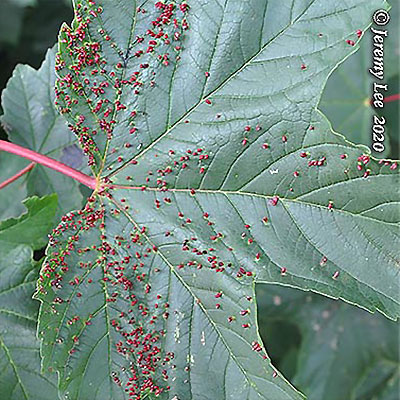
 |
|
Scientific Classifications explained » Amphibians » Ants » Aphids » Bees » Beetles » Birds » Bugs » Butterflies » Caterpillars » Damselflies » Dragonflies » Earwigs » Flies » Frog/Leafhoppers » Fungi » Galls » Grasshoppers » Harvestmen » Hoverflies » Lacewings » Ladybirds » Leaf Mines » Lichens » Mammals » Millipedes » Mosses » Moths » Sawflies » Slugs » Snails » Spiders » Trees & Shrubs » Wasps » Wild Flowers » Woodlice » Postboxes |
UK Nature > Galls > Sycamore Gall Mite

Gall causer: Aceria cephalonea Common Name: Sycamore Gall Mite Appears as lots of small red lumps (galls) which are about the size of a pinhead on the upper surface of young leaves, giving the appearance of a rash of pimples. The galls are caused by tiny mites (less than 0.2mm long). The immature and adult mites emerge in the spring after overwintering in bark crevices and other tiny spaces. As they pierce individual cells to feed on the plant tissue the surrounding cells are prompted to divide, therefore enlarging and forming the gall. By mid-May the mites start to lay eggs within the galls and several generations can occur over a season. The adults leave the galls in autumn before leaf fall to overwinter. Other than the affect to the appearance of the leaves, this pest does little lasting damage. It affects Sycamore trees (Acer pseudoplatanus), some ornamental acers and hedge maples (Acer campestre). More prevalent on young trees. The symptoms occur from April onwards. |
|

https://www.uknature.co.uk is a website dedicated to showing the immense diversity of UK nature and wildlife. Our vast range of habitats, from lowland arable to snow covered mountains, from storm-ravaged coastlines to peaceful inland freshwater lakes and rivers, from dry, sandy heaths to deciduous and coniferous forests, all these habitats contribute to the abundance of UK nature. We have wild birds in huge numbers either residing or visiting our shores (597 recorded species as at July 2013) and we must also not forget the humble back garden with its grass lawns, flower beds filled with nectar rich flowers, shrubs and trees, all designed to attract huge numbers of insects such as bees, moths, butterflies and hoverflies; and finally the small ponds which provide safe havens for frogs, toads, newts and even slow worms and grass snakes. www.uknature.co.uk is the showcase for my personal passion, photographing uknature in all its glory. I sincerely hope you all enjoy the fruits of my labours. This site and all images contained therein is © Jeremy Lee 2004 - 2025. All Rights Reserved. Site design by Jeremy Lee. Site development & IT Support by Stuart Lee. |